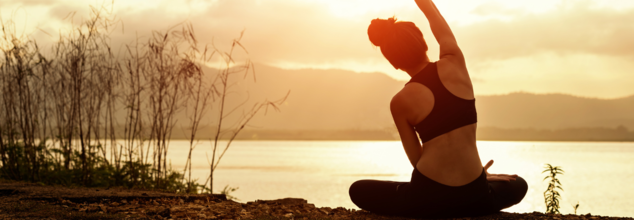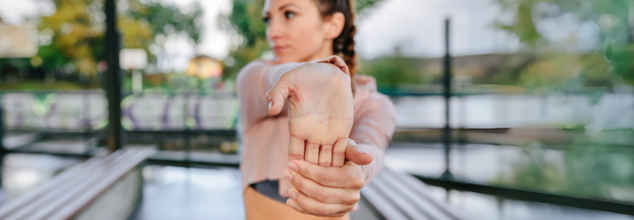- Health Conditions A-Z
- Health & Wellness
- Nutrition
- Fitness
- Health News
- Ayurveda
- Videos
- Medicine A-Z
- Parenting
- Web Stories
Peace Of Mind: Boost Your Brain Health And Wellbeing With Yoga- 3 Asanas To Perform Everyday

Yoga and brain (Credit-Canva)
Yoga is a big part of our culture and history. As science progresses more with each day, we learn new and interesting things like how much yoga can actually impact our lives. Many studies have shown that yoga not only impacts your physical health but in many ways, can transform your mental health. Yoga is a nuanced exercise that brings your body and mind together, enabling many people to work better.
When you are performing the poses for yoga, you are told to keep your breathing in check while also maintaining your posture. This helps you learn how to multitask on seemingly insignificant things. Slowly, this multitasking also seeps into your daily life, equipping you to have a smooth routine. When you meditate in yoga, you give your brain some time to be self-aware and self-conscious.
In this day and age of social media, many people choose to remain in their small bubbles forgetting about their surroundings. But through your focus, not only are you giving time to yourself, but you are also making sure you are aware of your surroundings and sharp!
Ways Yoga Affects Your Brain and Keeps You Healthy
Yoga has the ability to change your brain and how it functions. Here are some things you will see an improvement in when you start doing yoga consciously.
Reduces stress and anxiety
Regular yoga practice can help activate the parasympathetic nervous system, which is responsible for relaxation and stress reduction. This can lead to decreased levels of cortisol, the stress hormone, which can have a negative impact on both physical and mental health. By reducing stress and anxiety, yoga can improve overall well-being and promote a sense of calm and balance.
Improves mood
Yoga can boost mood by increasing the levels of neurotransmitters like serotonin and dopamine, which are associated with happiness and well-being. These neurotransmitters play a crucial role in regulating mood and emotions. By increasing the production of these neurotransmitters, yoga can help alleviate symptoms of depression and anxiety.
Enhances cognitive function
Studies have shown that yoga can improve cognitive function, including memory, attention, and problem-solving skills. This is likely due to the increased blood flow and oxygenation of the brain that occurs during yoga practice. Additionally, yoga can help reduce stress and anxiety, which can impair cognitive function.
Increases grey matter
Yoga has been linked to an increase in grey matter in the brain, which is associated with cognitive function, emotional regulation, and sensory perception. Grey matter is essential for learning, memory, and decision-making. By increasing grey matter volume, yoga can enhance these cognitive functions.
Improves neuroplasticity
Yoga can enhance neuroplasticity, the brain's ability to change and adapt. This is important for learning, memory, and recovery from brain injuries. By improving neuroplasticity, yoga can help the brain form new connections and adapt to changing circumstances.
Reduces inflammation
Chronic inflammation in the brain has been linked to cognitive decline and neurodegenerative diseases. Yoga can help reduce inflammation in the brain, potentially protecting against these conditions. By reducing inflammation, yoga can improve brain health and prevent cognitive decline.
Improves sleep quality
Yoga can help improve sleep quality by reducing stress and anxiety, which can disrupt sleep. By promoting relaxation and reducing stress, yoga can help you fall asleep more easily and sleep more soundly.
Boosts self-esteem
Regular yoga practice can boost self-esteem and body image by promoting a sense of self-awareness and acceptance. Yoga can help you develop a positive body image and feel more confident in your abilities.
Increases mindfulness
Yoga can help increase mindfulness, the ability to be present in the moment and focus on the present. This can improve mental clarity, reduce stress, and enhance overall well-being. By practising mindfulness, you can learn to manage stress more effectively and cultivate a sense of inner peace.
3 Daily Yoga Asanas to Perform to Stay Healthy
Yoga asanas, or poses, are designed to strengthen and balance the body while calming the mind. In this article, we’ll explore three essential yoga asanas that are perfect for daily practice. These poses not only help in maintaining physical health but also promote mental clarity and relaxation:1. Downward-Facing Dog (Adho Mukha Svanasana)
This pose stretches the entire body, improves circulation, and strengthens the arms, legs, and back. Begin on all fours, lift your hips towards the ceiling, and straighten your legs, forming an inverted V shape. Hold for 30 seconds, focusing on your breath.
2. Warrior II (Virabhadrasana II)
Warrior II enhances strength, stability, and endurance in your legs and core. Stand with your legs wide apart, turn one foot out 90 degrees and the other slightly in, bend your front knee, and extend your arms parallel to the ground. Gaze over your front hand and hold for 30 seconds on each side.
3. Child’s Pose (Balasana)
A restful pose that stretches the back, hips, and thighs while promoting relaxation and reducing stress. Kneel on the floor, sit back on your heels, stretch your arms forward on the ground, and lower your forehead to the mat. Hold for 1-2 minutes, focusing on deep, calming breaths.
Fixing Your Posture Is More Than Just Sitting Straight – Yoga Poses That Benefit Your Spinal Health

(Credit-Canva)
Fixing your posture is about more than just sitting up straight. Specific yoga poses can really help your back and make your spine healthier. These poses gently stretch and make the muscles that support your spine stronger. This leads to better alignment, less pain, and easier movement over time.
The reason why people who have poor posture are encouraged to do yoga is because it allows your core muscles to grow stronger and when you have a strong core your body finds it much more easier to support your back. Yoga also makes you more flexible, so your back can bend and twist more easily. Plus, it improves your body awareness. This means you'll notice how your body feels and holds itself, helping you to correct your posture before you even start to slouch.
Yoga Poses That Help You Fix Your Posture
Fixing your posture is about more than just sitting up straight. Specific yoga poses can really help your back and make your spine healthier. These poses gently stretch and make the muscles that support your spine stronger. This leads to better alignment, less pain, and easier movement over time.
Cow Pose (Bitilasana)
This gentle pose helps your spine move more freely by arching your back. It stretches your stomach and neck, making your spine more flexible and ready for other movements.
Downward-Facing Dog (Adho Mukha Svanasana)
This basic yoga pose makes your whole spine longer, from your tailbone to the top of your head. It stretches your legs and strengthens your arms, taking pressure off your back and helping your whole body line up correctly.
Plank Pose
Plank is fantastic for building a strong core, which is super important for a healthy spine. It works your stomach, back, and shoulder muscles, teaching your body to stay straight and preventing slouching by making you more stable.
Sphinx Pose
This easy backbend gently curves your spine, which is good if you sit a lot. You lie on your belly and lean on your forearms. Sphinx opens your chest and strengthens your lower back, helping your spine keep its natural curve and reducing stiffness.
Cobra Pose (Bhujangasana)
Cobra is a deeper backbend than Sphinx, making your whole back stronger and more flexible. When you lift your chest using your back muscles, it stretches your chest and stomach, improving how your spine moves.
Seated Twist
Seated twists gently turn your spine, making it more flexible and releasing tightness. This pose helps your insides and stretches your back muscles, keeping your spine hydrated and mobile, and improving posture by balancing your muscles.
Cat Pose (Marjaryasana)
Often done with Cow Pose, Cat Pose gently rounds your spine, stretching your back and releasing tension. It improves spinal flexibility and coordination, helping to warm up the back muscles and improve overall spinal mobility.
Child's Pose (Balasana)
This restful pose gently stretches the lower back and hips, decompressing the spine. It calms the mind and body, providing a gentle release for spinal tension and encouraging relaxation, which can greatly benefit overall back health.
Bridge Pose (Setu Bandhasana)
This pose strengthens the back muscles, glutes, and hamstrings while opening the chest and shoulders. It helps to lengthen the spine, counteracting the hunching often seen with desk work, and improves overall spinal support and posture.
Want To Exercise More Tomorrow? How A Simple Bedtime Routine Can Boost Physical Activity By 30 Minutes

Credits: Canva
For most people (add me!), the daily struggle to fit more exercise into an already hectic routine is a battle against fatigue, motivation, and not least of all, time but strangely the answer lies not in trying to find that ideal workout or buying new running shoes? A significant new study, suggests that a simple change to your bedtimes—going to bed earlier, that is—may hold the key to a more active lifestyle.
The study, released by Monash University scientists in Australia, examined the connection between bedtime and exercise. Although it does not unquestionably prove that an early night leads to more exercise the next day, the results strongly indicate a connection. The scientists analyzed wearable information from close to 20,000 individuals over the span of a year, creating a wealthy dataset that contained nearly six million night-and-day time stamps.
Their key discovery: people who went to bed earlier tended to engage in more moderate-to-vigorous physical activity the following day. Those who hit the hay at 9 p.m. clocked in an average of 30 more minutes of exercise the next day than those who went to bed at 1 a.m. Even an 11 p.m. bedtime, which was the average among participants, resulted in 15 fewer minutes of movement compared to the early birds.
Why Earlier Bedtime May Lead to More Exercise?
The relationship between sleep timing and exercise is more involved than just getting extra sleep. The research revealed that even if individuals had their typical level of sleep, sleeping earlier than usual still increased physical activity the following day. What this implies is that sleep timing, rather than duration, has an independent contribution in the regulation of our energy and motivation towards exercise.
Psychologist Josh Leota, a lead researcher, thinks that this finding might provide a straightforward but potent public health message. "Instead of pushing for sleep and activity separately, campaigns might push for earlier bedtimes to promote more active lives naturally," he explained.
The reasons are both physiological and behavioral. Late sleepers may naturally be more fatigued during the day or experience what researchers call “social jet lag”—a mismatch between biological rhythms and social schedules like a 9-to-5 job. This can reduce not only sleep quality but also daytime energy and motivation, ultimately impacting one’s willingness to exercise.
Strangely enough, people who went to sleep earlier but still slept for the same number of hours that they usually do tended to achieve personal records for their levels of physical activity. This indicates that it's not only about sleeping more—about when you sleep.
Why would earlier bedtimes lead us to be more likely to get moving? The researchers suggest a few reasons:
Less social jetlag: Most individuals' internal sleep clocks ("chronotypes") don't fit typical 9-to-5 routines, creating "social jetlag"—a discrepancy between internal and external schedules. This may result in more disturbed sleep and more daytime sleepiness, draining energy for exercise.
Less late-night distraction: Late-night activity usually translates into more computer/TV time and less time for restorative sleep, which leaves individuals drowsy and less motivated to exercise.
More regular wake times: While the study did not specifically quantify wake-up times, having an earlier bedtime may naturally result in waking up sooner and feeling more alert, with a greater chance of squeezing in exercise before the demands of the day can fill the schedule.
Interestingly, the research also discovered that individuals who slept for an average of five hours recorded 41.5 more minutes of exercise than those who slept for an average of nine hours. This does not, however, indicate that a shorter sleep period is more conducive to fitness. Prolonged lack of sleep can disable the gains of exercise, raise injury risk, and harm overall health. Strive for a healthy equilibrium: sufficient sleep for recovery, but not a quantity so high that it pushes out time and energy for activity.
How to Make Earlier Bedtimes a Part of Your Routine?
So, how do you take this research and turn it into action? If you're motivated to attempt changing your bedtime, here are some real-world strategies to make the transition smoother and prepare yourself for more energetic days:
1. Wind Down Slowly: Begin by creating a "digital sunset" 30 to 60 minutes prior to your desired bedtime. Switch off screens and dim the lights to signal your body that it is time to sleep.
2. Develop a Sleep Ritual: Read, meditate, or do some light stretches. This signals to your body that it's time to unwind.
3. Adjust in Increments: You don't need to transform your schedule in one night. Start by going to bed 15 minutes early every night until you hit your target bedtime.
4. Align with Your Chronotype: We all have an innate circadian rhythm. Although this study indicates advantages from sleeping earlier, adjust your bedtime to suit your body's natural schedule without sacrificing sleep quality.
5. Prioritize Sleep Hygiene: Make your bedroom cold, dark, and silent. Invest in blackout curtains, white noise machines, or whatever will let you sleep better.
6. Keep Consistency: Attempt to keep the same wake and sleep times even on weekends to maintain a stable rhythm.
While the best exercise regimen or the latest piece of exercise equipment can be beneficial, at times the most effective changes are the most straightforward. This research indicates that shifting your bedtime forward—even by one hour—may make you more active, energized, and eager to work out the following day.
Health On Your Fingertips - Your Fingers Can Reveal How Much Endurance You Have

(Credit-Canva)
We have all seen people who are naturally good at any sport they pick. While anyone can practice sports and get better, there is a question of whether the other people who play better are ‘gifted’ or are they doing things differently. The answer could be both! There are certain people who are naturally better at sports, and research has shown that there is a simple sign that may indicate the same.
Take a look at your hand right now. Is your ring finger longer than your pointer (or index) finger? If it is, new research suggests you might have a natural gift for sports. Published in the American Journal of Human Biology, the study looked at many smaller studies, found that people whose pointer fingers are shorter than their ring fingers (this is called a lower 2D:4D digit ratio) tend to have better endurance and exercise tolerance tougher and longer workouts better.
This research is thought to be the most complete study so far that connects finger length to how well people can exercise and perform in endurance activities. One expert from the study explained that if you have this lower digit ratio, you're more likely to do well in sports that need a lot of stamina, like long-distance running, biking, rowing, or team sports that require a lot of energy. This finger ratio could even be a cheap and easy way to check someone's basic heart and lung fitness.
Study Found About Fitness and Finger Length
The researchers looked at 22 different studies that included over 5,000 people from 12 countries. They specifically checked how the lengths of people's pointer (2D) and ring (4D) fingers were related to how fit their heart and lungs were. This included how well their bodies used oxygen during hard exercise and how long they could work out before getting tired.
The results showed that people with a lower 2D:4D ratio (meaning their pointer finger was shorter than their ring finger) had better exercise tolerance and could keep going longer. However, this finger ratio didn't seem to be linked to other athletic abilities, like how much oxygen their body could use overall.
Can Finger Length Predict Other Things About Your Health?
Other studies have also connected finger length ratios to different traits, like being more physically aggressive or more competitive. The lower 2D:4D ratio has also been linked, though not strongly, to other signs of being good at sports, such as having a stronger grip, being able to sprint faster, and having more explosive power. Some research suggests this link is stronger in men and in sports that need a lot of stamina or sudden bursts of power.
A few studies have even found that people with lower 2D:4D ratios have bigger jumps in the hormone testosterone during tough exercise, which might help them deal with discomfort. Also, top athletes often have lower 2D:4D ratios than people who aren't athletes. However, experts point out that this isn't true for every sport, and the effect is usually small.
Other scientists, however, question how much finger length really matters in sports. They believe it's unlikely that finger size can truly predict someone's ability to endure. Most of the research on finger ratios has only shown connections, not direct causes. More studies are needed to clearly understand why these links exist and if they have any real use in finding talent or in athletic training.
What definitely does improve your fitness, according to experts? Training. Regular exercise, both cardio and strength training, can hugely improve your heart and lung fitness. It's much more likely that your training will affect your performance than your finger length.
© 2024 Bennett, Coleman & Company Limited

